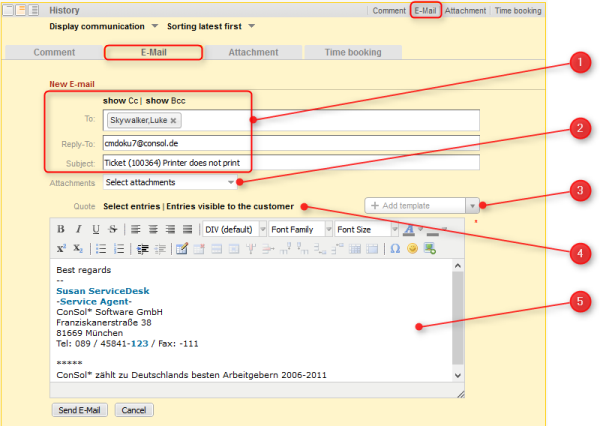Open topic with navigation
E-Mails
The Web Client can send and receive e-mails related to tickets. E-mails are always sent from within the ticket they concern. You can send e-mails to the customer and to any recipient with a valid e-mail address. All e-mails sent from the Web Client are displayed in the ticket history. If the recipient replies to the e-mail, the reply is also added to the ticket history. The ticket history therefore provides an overview of all e-mail communication, including attachments.
Sending E-Mails
To draft the e-mail click the E-Mail link in header of the History Section. The background of the history section turns yellow to indicate that it is in edit mode. If the section is already in edit mode, you can also write an e-mail by clicking the E-Mail tab. Depending on your system configuration, the Rich Text Editor might already contain a certain template, e.g., your signature. You can edit the text before sending the e-mail.
Figure 62: Sending an e-mail
- Standard e-mail fields
- To
This field contains the recipient of the e-mail. In most CM systems, it is initially filled with the e-mail address of the ticket's main customer (if provided). Depending on the system configuration, you see the e-mail address and/or the name of the recipient. You can remove the recipient by clicking the little cross next to the name and you can add multiple recipients separated by a comma. As soon as you start typing the recipient's e-mail address or name, the CM system suggests matching recipients.
- Cc/show Cc
This field contains the recipients which should receive a copy of the e-mail. If the Cc field is not displayed, click the show Cc link.
- Bcc/show Bcc
This field contains the recipients which should receive a blind copy of the e-mail. If the Bcc field is not displayed, click the show Bcc link.
- Reply-To
This field contains the reply-to address used in the e-mail. This is usually a system address. Do not change it!
- Subject
This field contains the e-mail subject. The subject is set automatically by the system. Do not change it! Otherwise the replies might not be correctly attached to the ticket.
- Attachments
Here you can select attachments to be sent with the e-mail. You can only select attachments which are already added to the ticket or included in a selected template, i.e., it is not possible to upload a new attachment here. This field is hidden if the ticket does not have any attachments.
- Add template
Here you can select one or several templates for the e-mail text. Depending on your system configuration, a standard template might be initially selected. You can select another template or edit the template text before sending the e-mail. Please see Templates for Creating E-Mails or Comments for a detailed description of templates.
- Quote
Here you can quote entries from the ticket history. If you click Select entries, you can select from all communication entries (comments and e-mails) in the ticket history. Click Entries visible to the customer to limit the selectable entries to those entries which the customer is allowed to see.
- Rich Text Editor
This field contains the e-mail body, i.e., the text which is sent. You can format the e-mail text using the features of the Rich Text Editor.
Draft your e-mail and click Send E-Mail to send it to the indicated recipients.
Replying to E-Mails and Forwarding E-Mails
You can reply to and forward an e-mail from the ticket history.
Figure 63: E-mail actions
To reply to an e-mail, open the Action menu of the desired e-mail and click Reply. The Rich Text Editor is opened. The sender of the original e-mail is automatically selected as a recipient in To: and the original e-mail is quoted under in reply to. You can edit and send your e-mail as described in Sending E-Mails.
To forward an e-mail, open the Action menu of the desired e-mail and click Forward. The Rich Text Editor is opened. The original e-mail is quoted under Original Message and you have to specify the recipient in the To: field. You can edit and send your e-mail as described in Sending E-Mails.
